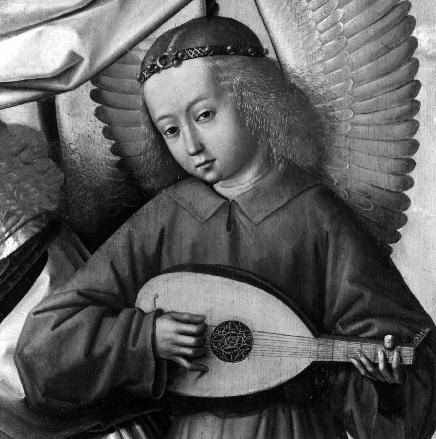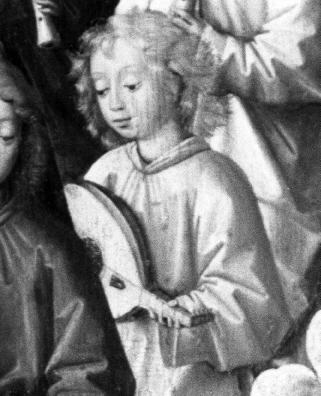



|
This huge painting, it measures 78 x 63 inches, is of particular interest for lute players and makers because it shows one of the very first examples of a truly renaissance lute as well as one of the last examples of a late medieval lute in the same picture.
I don't know much about the artist, except that he worked in Bruges at about the same time as Hans Memling, c.1480 - c.1510 and that his style is clearly Flemish.
The beautiful little lute in the foreground is so clearly shown that even the rose could be copied. I partly chose this picture, though, because there has recently been some discussion on the lute-net of the possibility of using the thumb to stop the bottom course in the music of Francesco da Milano. In looking for evidence of this usage I came to the conclusion that the practice was common up to about 1520 but only on five course lutes, such as this one. Partly, I suspect, this is because the five course lute had an even narrower neck than the six course, making the procedure that much easier, even for those with normal length fingers. Here the thumb is very clearly clamped over the bottom course, not just poking out beyond the back of the neck as is often the case. It appears to be strung with octaves on courses three, four and five; certainly the lowest course fundamental is a substantially thick string.
The right hand position too is right up to date, there is no plectrum, the little finger is very clearly placed on the soundboard. I daresay Matanya Ophee will say that this hand shows no evidence of being used for plucking the strings, but, although he would have a point, I feel more leniently disposed to the artist, and suggest perhaps the player has been learning with Chris Wilson and that the fingers have just plucked a chord and come to rest as a semi-fist!
The rose itself is interesting, especially as it is on a renaissance lute, because it has a gothic design reminiscent of church window tracery. As the classic renaissance rose designs often carry seemingly Middle Eastern designs of six-pointed stars in the interlace patterns common in Islamic art; and as the lute is known to have derived from the Islamic Oud it has often been assumed that these rose designs are direct descendants of the [forgotten] ancestor the Oud. However when I look at most medieval rose designs they are much more commonly gothic in form; the six-pointed star is conspicuous by its absence. This may be because most paintings of medieval lutes are Christian in origin; in other words, if the Church was paying for the painting it forbade the use of pagan symbolism. However it also seems to be true of less overtly religious pictures. This paucity of intervening examples makes me believe that the renaissance use of the six-point interlace was more due to the direct influence of Middle Eastern design at the time, than any kind of race memory of the lute's ancestor the Oud.
Finally the form of this little lute is perfect for a little Venere or Harton lute of about a century later. The bridge too is a perfect example of the form used much later by Gerle. This lute must have been the very latest thing for the period of the painting, which might explain its prominence in the picture. It certainly makes me want to date the painting to the very last date the experts will allow.
Now to move on to the other lute, half hidden in the group of musicians in the opening of the heavens. This too is a five course lute, though seemingly rather larger. It seems to be made with a striped back of alternate dark and light ribs. But it has two features which date it very clearly as a late medieval lute of the type that became briefly popular around 1480.
First, if you look carefully you can see that it has ribs which bend into the neck joint in quite a tight curve. This was very common for medieval lutes and may imply that the neck and neck-block were originally made of one piece of wood with the ribs overlapped onto it and rebated in. At this date the curve had become as tight as possible, perhaps to facilitate playing high up the neck.
Second, and more specific, is the lancet-window shaped second rose between the main circular rose and the fingerboard. This feature suddenly appears in paintings of lutes at about 1480 and becomes particularly common in Flemish paintings of the period. Curiously there is one surviving instrument of the period which also has this feature, it is the upright clavicytherum in the Royal College of Music museum in London. This has also been independently dated to about 1480 and comes from South Germany, where most of the lutes were being made before the big exodus of talent to Italy at the turn of the century. By 1500 this brief fashion appears to have been over, [perhaps because it did nothing much for the sound?]
This player's right hand cannot be seen but I seem to feel a plectrum position suggested by what of that arm is visible. The head of the lute is very slightly down; it seems a more medieval position.
The fact that this lute has been hidden away in the background does suggest to me that by the time of our painting this feature was no longer the very pinnacle of fashion. Another reason perhaps to push the dating as late as possible?
This is a comment from Ronny Andersson via the lutenet, I agree with his analysis of the problems of standing playing positions. In fact, as he says, the great majority of medieval players shown standing hold their lutes in an almost exactly horizontal position.
"The October picture by David Van Edward shows clearly two lutenists that
are standing with their lutes placed against their chest. It is not a
easy task to hold a lute in this position if you play with a plectrum.
If you shall hold an oud in this position then must you hold the neck
paralell to the ground and not with the peag- head down . The problem is
that you must secure a safe grip to avoid to drop the lute. The left
hand must give support and the lute bowl must be placed against the
chest. This position misplaces the relationship between plectrum and
the strings and the correct position as I have when I'm seated is
impossible to obtain as standing. The oud has a large bowl and as I said
is it already difficult to stand and hold the oud . I find the same
thing occur when I'm holding an 1/2 size oud, little bit easier to hold
due to the smaller size but it is still necessary to have the bowl
against the chest, the neck paralell to the ground and it is still
impossible to play correctly. I remember when I saw Martin Best playing
his oud, a poor oud player but when he was standing he hold his oud
against the chest and with the neck paralell to the ground.
The correct playing position for an oud looks nearly like if you were
holding a rifle with the right elbow pointed backwards and the neck of
the oud pointed in the opposite direction like the barrel of the rifle,
a position that you can't obtain when you standing.
The correct postion for the medieval lute must be like the oud is being
hold and played.
In the October picture can't I see or assume medieval position that was
so obvious in the Maximilian picture. It should be interesting to hear a
finger player's opinion to the standing position.
Ronny"
|
|
If anyone has any comments about these pictures which differ from or expand
on mine, please do either email me direct or submit them to the lutenet at antispam/lute@cs.dartmouth.edu and I will add them to this page. Do please adjust this address by hand to remove antispam/ |
| Lutes | Bows | |
| History of the Lute | Build your own Baroque Lute | Build your own Renaissance Lute |
Copyright 1998 by David Van Edwards